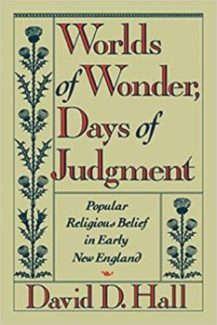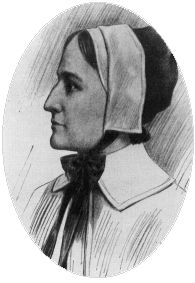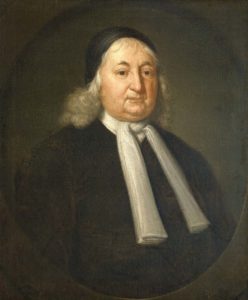Book Review: Worlds of Wonder, Days of Judgment

Popular religious life in New England, unlike Europe, had no Christmas, cathedrals, abbeys, liturgies, wedding ales, or anything done away with by the Protestant Reformation of 1517. Yet the settlers did come with “folk” beliefs, sometimes older than Christianity, that had not been specifically targeted by the Reformation or local clergy.
In this history of popular religious belief in 17th-century New England, David D. Hall explores the “cluster of meanings” of what we call religious, such as the symbolism of the church, rituals, and the supernatural. Protestant religion was embedded in the daily life of early New Englanders, who used their belief in God’s Providence to help them navigate dangerous threats to their existence. Their Puritanism (a word Hall avoids) was not rigid but fluid and sometimes contradictory. While Hall states this is a history of lay religion, it also examines the relationships between the laity and clergy, whose authority was sometimes questioned.
Unlike in Europe, these “folk” were middle class yeoman, housewives, merchants, and craftsmen who knew well the “superstitions” they must reject from Catholicism. They did, however, enjoy astrological information printed in almanacs written by clergy, anti-witchcraft magic, and fortune tellers. There was an “accommodation” between such wonders and religion. Hall sees magic not as separate from religion but working in tandem with it, though belief in magic declined by the 1700s.
This was not a matter of the illiterate believing in magic, as most New Englanders could read. Literacy was central to Protestantism and Bible reading. Direct access to the word of God through reading the Bible fundamentally separated them from Catholics. It inadvertently opened up the space for lay people to disagree with ministers’ readings of the Bible. Literacy also gave readers access to less Godly books, as Bibles were printed and sold by businessmen who marketed other materials, both religious and decidedly not religious.
TIME PERIOD: 1620-1700
Chapter 1: The Uses of Literacy

Broadsides, ballads, self-help, Bibles, and religious readers were read by early New Englanders, who prided themselves on literacy. Clergy faced a problem—they claimed the Word was not mediated, yet these often Harvard-educated ministers mediated the Word. While clergy wrote many of the books printed, booksellers and printers operated in a competitive marketplace, which got going in Boston after 1660.
Hall isolates three types of reading: Godly books (“godlies”), romances, and the “country” reader who preferred stories of adventure and wonder. Yet even these godlies might feature sensationally entertaining accounts of sinful pleasures, emotionality and torturous pains such as a doomsday sermon, which printers embellished to drive sales. These began to take on less godly forms.
Almanacs were a place where popular religion and culture changed. Ministers attempted to censor almanacs that included Valentine’s Day, Michaelmas, and Christmas, named instead of numbered months, and inappropriate humor. The marketplace won and such almanacs continued their bawdry ways.
Learning (i.e. clergy) was important due to contradictions in the Bible, yet clergy was increasingly challenged in a colony where readers sometimes stepped out of bounds in interpreting these contradictions. Both the marketplace and the increase in popular participation in civic life threatened the power of clergy.
Chapter Two: A World of Wonders
Theirs was an enchanted world full of ghosts and voices. But enchantments fell back not simply on the imaginations of a superstitious people, but on the Bible, with its “visions, voices, witches, and strange deaths,” and other classics. Popular books of the day drew on the time-worn greats such as Vergil, Pliny, Plutarch, Seneca, Cicero, and Josephus.
Hall argues that these wonders built on four old systems of ideas: Greek meteorology, astrology, apocalypticism, and natural history. But the most important doctrine was the Providence of an angry God, wrapped up in folklore, all of which revealed a pattern. Wonders revealed the underlying order of God.
Fact: Harvard postponed commencement in 1684 because it fell too close to an eclipse (94).
Dissenters like Anne Hutchinson, fortune tellers, and clergy all exploited the ambiguities of Wonder, though clergy most vigorously expounded the wonders as God’s punishment and evidence of Divine Providence, which was increasingly questioned by the people. Hutchinson’s followers, Quakers, and Baptists as well as others differed from the orthodox clergy’s views.
Chapter 3: The Meetinghouse
Lay settlers learned about the language of spiritual experience in part through Sunday sermons, catechisms, reading the Bible, and Godlies. They occasionally found that what they read differed from the sermon, but for the most part they took their self-understanding and that of Christianity from preachers. Nevertheless, seeing differences they came to through their own understanding gave them the confidence to question ministers on important matters such as baptism and grace. By the 1640s, ministers complained about “declension,” an increasing lack of dedication to the Puritan cause.
Testifying to the experience of grace usually involved experiencing oneself as a terrible, unworthy sinner and feeling terrified by that realization, shortly followed by hope for grace through Christ’s promise of forgiveness. Yet only half, if not fewer, of lay people ever testified and so never achieved full membership. Everyone, though, understood the demand their religion made on them: the struggle to work free of sin.
Chapter 4: The Uses of Ritual

Though early New Englanders rejected Catholic ritual, they developed their own to ground them in meaning and help them deal with dangers. Hall highlights the witch-hunt, criminal confession, the spectacle of public executions, covenant renewal, prayer notes, and most especially prayer and fasting. Criminals were killed as well as religious dissenters, including Quakers and Baptists.
Confession was a key point of all of these rituals, which were as stark as possible. “Ritual was a means of checking the disorder of the natural world, of limiting the danger of God’s judgment.” It also kept the social order in check. Community fasts were the most common form of ritual, which bonded the people as a group against danger, centered around the belief that God favored New England and gave it to the righteous to own and make prosperous.
Chapter 5: The Mental World of Samuel Sewall
The diaries of Samuel Sewall, a Bostonian mechant and magistrate, demonstrate Hall’s theories in practice. He struggled with sin while working to keep his family and community safe, “yearning for protection.” Prayer and generosity helped with sin, and books became ritual for this well-educated intellectual.
The old enchanted world began, in the 17th century, to be dislodged by new sciences. The book marketplace increasingly shifted from fantastic wonders explained by god’s providence to less godly entertainment. Because much of early New England’s population was not thoroughly engaged in these stark rituals, the laity began to consider other forms of Christianity and philosophy to explain their world.
Was this useful? Keep us going with a quick tip. Thank you!